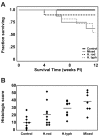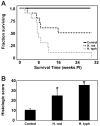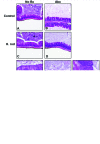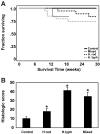Helicobacter typhlonius and Helicobacter rodentium differentially affect the severity of colon inflammation and inflammation-associated neoplasia in IL10-deficient mice - PubMed (original) (raw)
Helicobacter typhlonius and Helicobacter rodentium differentially affect the severity of colon inflammation and inflammation-associated neoplasia in IL10-deficient mice
Maciej Chichlowski et al. Comp Med. 2008 Dec.
Abstract
Infection with Helicobacter species is endemic in many animal facilities and may alter the penetrance of inflammatory bowel disease (IBD) phenotypes. However, little is known about the relative pathogenicity of H. typhlonius, H. rodentium, and combined infection in IBD models. We infected adult and neonatal IL10-/- mice with H. typhlonius, H. rodentium, or both bacteria. The severity of IBD and incidence of inflammation-associated colonic neoplasia were assessed in the presence and absence of antiHelicobacter therapy. Infected IL10-/- mice developed IBD with severity of noninfected (minimal to no inflammation) < H. rodentium < H. typhlonius <mixed H. rodentium + H. typhlonius (severe inflammation). Inflammation-associated colonic neoplasia was common in infected mice and its incidence correlated with IBD severity. Combined treatment with amoxicillin, clarithromycin, metronidazole, and omeprazole eradicated Helicobacter in infected mice and ameliorated established IBD in both infected and noninfected mice. Infection of IL10-/- mice with H. rodentium, H. typhlonius, or both organisms can trigger development of severe IBD that eventually leads to colonic neoplasia. The high incidence and multiplicity of neoplastic lesions in infected mice make this model well-suited for future research related to the development and chemoprevention of inflammation-associated colon cancer. The similar antiinflammatory effect of antibiotic therapy in Helicobacter-infected and -noninfected IL10-/- mice with colitis indicates that unidentified microbiota in addition to Helicobacter drive the inflammatory process in this model. This finding suggests a complex role for both Helicobacter and other intestinal microbiota in the onset and perpetuation of IBD in these susceptible hosts.
Figures
Figure 1.
Short-term survival and colitis severity in _Helicobacter_-infected adult IL10−/− mice. (A) Kaplan–Meier plot shows survival rate of adult IL10−/− mice infected with H. rodentium (H. rod), H. typhlonius (H. typh), or both (mixed) bacteria (short-term study). Control, _H. rodentium_-, _H. typhlonius_-, and mixed H. rodentium + _H. typhlonius_-infected groups contained 10, 10, 11, and 8 mice, respectively. Survival rates in _H. typhlonius_- and mixed infection groups were significantly decreased compared with the noninfected mice (P = 0.01 and 0.04, respectively). PI, postinfection. (B) Histologic scores (mean ± SEM) of mice infected at 7 to 8 wk of age and euthanized 11 wk after infection. Control, _H. rodentium_-, _H. typhlonius_-, and combined H. rodentium + _H. typhlonius_-infected groups contained 9, 10, 9, and 7 mice, respectively. Mice infected with H. typhlonius or both H. rodentium and H. typhlonius had significantly higher histologic scores than did the noninfected control group (P = 0.0005 and 0.0009, respectively, by Student t test).
Figure 2.
Long-term survival and colitis severity in _Helicobacter_-infected adult IL10−/− mice. (A) Kaplan–Meier plot shows survival rate of adult IL10−/− mice (n = 10 for each group) infected with H. rodentium (H. rod) or H. typhlonius (H. typh) in long-term experiments. Survival was significantly decreased in mice infected with either H. rodentium or H. typhlonius compared with noninfected control mice (P < 0.01 and 0.0001, respectively). (B) Histologic scores (mean ± SEM) of mice (n = 10 for each group) infected at 7 to 8 wk of age. Mice infected with H. rodentium or H. typhlonius had significantly higher histologic scores compared with the control group (P = 0.02 and < 0.001, respectively, by Student t test).
Figure 3.
Colon histology and neoplasia in Helicobacter_-infected and noninfected IL10−/− adult mice. The histologic appearance of the cecum is shown for noninfected control mice (A, B), mice infected with H. rodentium (H. rod; C, D), H. typhlonius (H. typh; E, F, K), or both (Mixed; G, H, L) and noninfected mice with inflammatory bowel disease triggered by piroxicam (I, J) in the presence (Abx) and absence (no Rx) of treatment with a 4-drug anti_Helicobacter regimen. Untreated IL10−/− mice infected with H. typhlonius or mixed H. rodentium plus H. typhlonius or noninfected mice exposed to piroxicam had marked mucosal hyperplasia with prominent inflammatory infiltrates that were totally abrogated by anti_Helicobacter_ treatment. Inflammatory changes in mice infected with H. rodentium alone are not evident at this magnification. Examples of neoplastic lesions seen in long-term _H. typhlonius_-infected (K, proximal colon) IL10−/− mice and mice infected long-term with both H. typhlonius and H. rodentium (L, cecum) are shown. All photomicrographs were taken at the same magnification; bar, 200 μm.
Figure 4.
Incidence of neoplasia in IL10−/− mice born to mothers infected with H. rodentium (H. rod), H. typhlonius (H. typh), or both (Mixed). Gray bars represent mice with only noninvasive gastrointestinal intraepithelial neoplasia (equivalent to dysplasia and carcinoma in situ), whereas black bars represent mice with at least 1 focus of invasive colonic adenocarcinoma. In pups born to _H. typhlonius_-infected mothers, neoplastic lesions were present in 24% mice examined, with invasive adenocarcinoma present in 18%. Neoplasia was present in 29% of pups born to mothers infected with H. rodentium, with 12% having invasive adenocarcinoma. Pups with H. typhlonius and mixed infection were significantly younger when examined than were control pups (P = 0.008 and 0.001, respectively). In adults, the incidence of colonic neoplasia in mice infected with H. typhlonius was 50% and 40% for total neoplasia and invasive adenocarcinoma, respectively. The incidence of colonic neoplasia in adults decreased as the severity of IBD decreased (compare with Figures 1 and 2), with 30% incidence of neoplasia in adult mice infected with H. rodentium alone. Invasive adenocarcinoma was not present in control (noninfected) or _H. rodentium_-infected adult mice.
Figure 5.
Survival and colitis severity in IL10−/− mice infected as pups. (A) Kaplan–Meier plot showing survival rate of pups born to the mothers infected with H. rodentium (H. rod), H. typhlonius (H. typh), or both (Mixed). Control, _H. rodentium_-, _H. typhlonius_-, and combined _H. rodentium_- and _H. typhlonius_-infected groups contained 21, 18, 19 and 7 mice, respectively. Pups born to mothers infected with H. typhlonius had significantly (P < 0.01) lower survival rate at 18 wk compared with control pups. (B) Histologic scores (mean ± SEM) of pups born to infected mothers. Control, _H. rodentium_-, _H. typhlonius_-, and combined H. rodentium and _H. typhlonius_-infected groups contained 20, 17, 17 and 7 mice, respectively. Pups born to dams infected with H .rodentium, H. typhlonius, or both H. rodentium and H. typhlonius had significantly higher histologic scores compared with the control group (P = 0.04, 0.001, and 0.01, respectively, by Student t test).
Figure 6.
Effect of anti_Helicobacter_ therapy on Helicobacter_-infected IL10−/− mice. Histologic scores (mean ± SEM) are shown for IL10−/− mice infected with H. rodentium or H.typhlonius at the age of 6 to 8 wk and treated with the 4-drug anti_Helicobacter combination after day 30 of infection. Treated control, _H. rodentium_-, _H. typhlonius_-, and combined H. rodentium + _H. typhlonius_-infected groups contained 7, 9, 9 and 8 mice, respectively. Nontreated control, _H. rodentium_-, _H. typhlonius_-, and combined H. rodentium + _H. typhlonius_-infected groups contained 9, 10, 9, and 7 mice, respectively. Survival rates did not differ between the groups of antibiotic-treated mice. Mice were euthanized at 11 wk after infection.
Figure 7.
Effect of anti_Helicobacter_ therapy on noninfected IL10−/− mice with colitis. Inflammatory bowel disease was induced by exposure to 200 ppm piroxicam for 7 d, after which mice were treated with the 4-drug anti_Helicobacter_ therapy combination for 16 d. Mice treated with anti_Helicobacter_ therapy had significantly lower histologic scores (mean score ± SEM, 11 ± 3; n = 10) compared with mice not treated with anti_Helicobacter_ drugs (31 ± 5; n = 8; P = 0.006).
Figure 8.
Quantification of H. rodentium and H. typhlonius in intestinal tissue and stomach. Three IL10−/− mice inoculated with both bacterial strains were studied. Tissue was collected on day 82 of infection. Quantification of the bacterial genomes was based on the presence of Ni/Fe hydrogenase and cdtB gene for H. rodentium and H. typhlonius, respectively. The number of copies of the bacterial genome is expressed per gram of tissue.
Similar articles
- Neonatal co-infection with helicobacter species markedly accelerates the development of inflammation-associated colonic neoplasia in IL-10(-/-) mice.
Hale LP, Perera D, Gottfried MR, Maggio-Price L, Srinivasan S, Marchuk D. Hale LP, et al. Helicobacter. 2007 Dec;12(6):598-604. doi: 10.1111/j.1523-5378.2007.00552.x. Helicobacter. 2007. PMID: 18001399 - Helicobacter infection decreases reproductive performance of IL10-deficient mice.
Sharp JM, Vanderford DA, Chichlowski M, Myles MH, Hale LP. Sharp JM, et al. Comp Med. 2008 Oct;58(5):447-53. Comp Med. 2008. PMID: 19004370 Free PMC article. - Infection with murine norovirus 4 does not alter Helicobacter-induced inflammatory bowel disease in Il10(-/-) mice.
Hsu CC, Paik J, Treuting PM, Seamons A, Meeker SM, Brabb TL, Maggio-Price L. Hsu CC, et al. Comp Med. 2014 Aug;64(4):256-63. Comp Med. 2014. PMID: 25296012 Free PMC article. - Enteric bacteria, lipopolysaccharides and related cytokines in inflammatory bowel disease: biological and clinical significance.
Caradonna L, Amati L, Magrone T, Pellegrino NM, Jirillo E, Caccavo D. Caradonna L, et al. J Endotoxin Res. 2000;6(3):205-14. J Endotoxin Res. 2000. PMID: 11052175 Review. - Helicobacter bilis Contributes to the Occurrence of Inflammatory Bowel Disease by Inducing Host Immune Disorders.
Peng W, Zhao X, Li X. Peng W, et al. Biomed Res Int. 2022 Aug 9;2022:1837850. doi: 10.1155/2022/1837850. eCollection 2022. Biomed Res Int. 2022. PMID: 35983246 Free PMC article. Review.
Cited by
- [Pathogenesis of colitis-associated neoplasms].
Vieth M, Neumann H. Vieth M, et al. Pathologe. 2012 Nov;33 Suppl 2:215-20. doi: 10.1007/s00292-012-1642-4. Pathologe. 2012. PMID: 23052342 Review. German. - Early life exposure to broccoli sprouts confers stronger protection against enterocolitis development in an immunological mouse model of inflammatory bowel disease.
Holcomb L, Holman JM, Hurd M, Lavoie B, Colucci L, Hunt B, Hunt T, Kinney M, Pathak J, Mawe GM, Moses PL, Perry E, Stratigakis A, Zhang T, Chen G, Ishaq SL, Li Y. Holcomb L, et al. bioRxiv [Preprint]. 2023 Jul 4:2023.01.27.525953. doi: 10.1101/2023.01.27.525953. bioRxiv. 2023. PMID: 36747766 Free PMC article. Updated. Preprint. - Ulcerative typhlocolitis associated with Helicobacter mastomyrinus in telomerase-deficient mice.
Eaton KA, Opp JS, Gray BM, Bergin IL, Young VB. Eaton KA, et al. Vet Pathol. 2011 May;48(3):713-25. doi: 10.1177/0300985810383876. Epub 2010 Oct 6. Vet Pathol. 2011. PMID: 20926734 Free PMC article. - Characterization of chromosomal instability in murine colitis-associated colorectal cancer.
Gerling M, Glauben R, Habermann JK, Kühl AA, Loddenkemper C, Lehr HA, Zeitz M, Siegmund B. Gerling M, et al. PLoS One. 2011;6(7):e22114. doi: 10.1371/journal.pone.0022114. Epub 2011 Jul 22. PLoS One. 2011. PMID: 21799775 Free PMC article. - Animal models of colitis-associated carcinogenesis.
Kanneganti M, Mino-Kenudson M, Mizoguchi E. Kanneganti M, et al. J Biomed Biotechnol. 2011;2011:342637. doi: 10.1155/2011/342637. Epub 2011 Jan 12. J Biomed Biotechnol. 2011. PMID: 21274454 Free PMC article. Review.
References
- American Veterinary Medical Association 2007. AVMA guidelines on euthanasia (formerly Report of the AVMA Panel on Euthanasia): Jun 2007 update. Available from http://www.avma.org/issues/animal_welfare/euthanasia.pdf
- Berg DJ, Zhang J, Weinstock JV, Ismail HF, Earle KA, Alila H, Pamukcu R, Moore S, Lynch RG. 2002. Rapid development of colitis in NSAID-treated IL10-deficient mice. Gastroenterology 123:1527–1542 - PubMed
- Boivin GP, Washington K, Yang K, Ward JM, Pretlow TP, Russell R, Besselsen DG, Godfrey VL, Doetschman T, Dove WF, Pitot HC, Halberg RB, Itzkowitz SH, Groden J, Coffey RJ. 2003. Pathology of mouse models of intestinal cancer: consensus report and recommendations. Gastroenterology 124:762–777 - PubMed
- Bouma G, Strober W. 2003. The immunological and genetic basis of inflammatory bowel disease. Nat Rev Immunol 3:521–533 - PubMed
Publication types
MeSH terms
Substances
LinkOut - more resources
Full Text Sources
Medical







